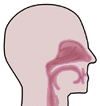  |
||
 |
March 2020Action of Phosphodiesterase Inhibitors on Olfactory Epithelial Stem CellsSmell loss is caused by many pathologies including viral-type illness, allergic rhinitis, head injuries, and external radiation. Each of these pathologies act to inhibit smell loss by acting on the olfactory epithelium which undergoes apoptotic degeneration as a result of these pathologies. The major mechanism underlying all of these pathologies is similar and involves inhibition of stem cell activation which normally occurs by the action of adenylyl cyclase III through the action of cAMP and cGMP. These pathologies act to inhibit growth factors secretion from the nasal mucus which normally stimulates stem cell function at the olfactory epithelium. Since stem cell activation is necessary to initiate growth and development of olfactory epithelial receptor cells any inhibition of this action causes the apoptotic changes observed in olfactory epithelium resulting in onset of smell loss. Phosphodiesterase (PDE) inhibitors can activate cAMP and cGMP if delivered directly to the olfactory epithelium by way of a nasal spray containing this substance. At The Taste and Smell Clinic in Washington, DC we have treated many patients with smell loss of many pathologies with several PDE inhibitors which have increased nasal mucus cAMP and cGMP which subsequently corrected the smell loss and in some patients restored olfactory function to or toward normal. To be presented at Experimental Biology 2020, San Diego, CA. |
|